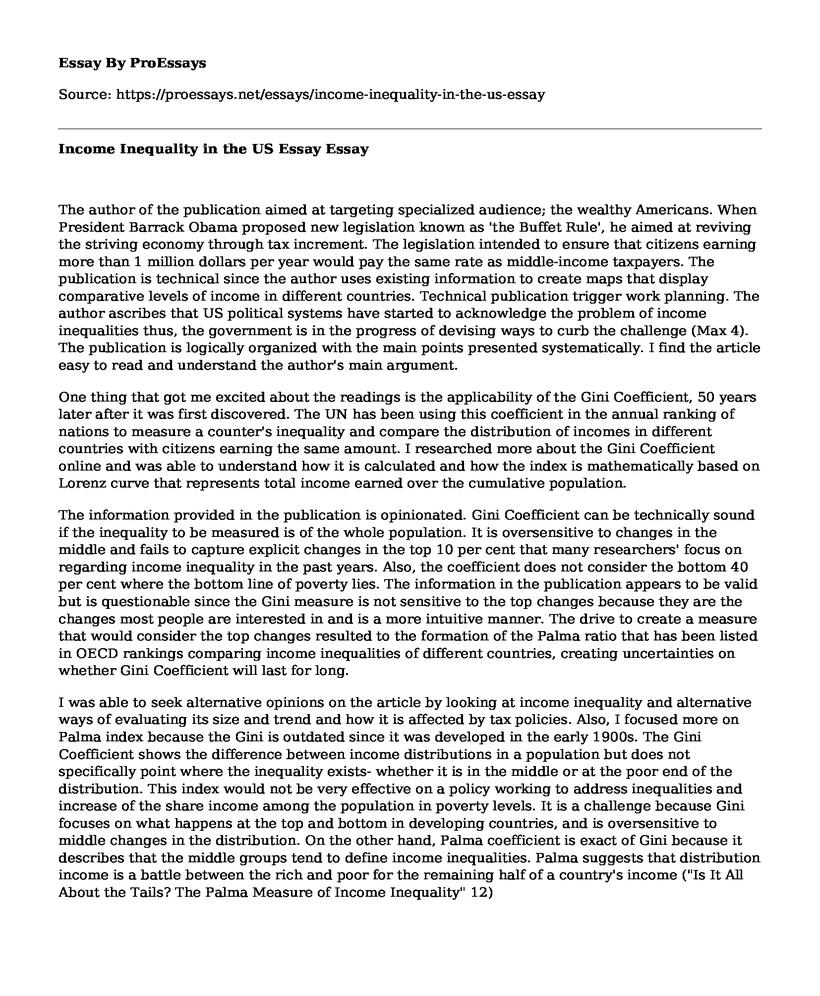The author of the publication aimed at targeting specialized audience; the wealthy Americans. When President Barrack Obama proposed new legislation known as 'the Buffet Rule', he aimed at reviving the striving economy through tax increment. The legislation intended to ensure that citizens earning more than 1 million dollars per year would pay the same rate as middle-income taxpayers. The publication is technical since the author uses existing information to create maps that display comparative levels of income in different countries. Technical publication trigger work planning. The author ascribes that US political systems have started to acknowledge the problem of income inequalities thus, the government is in the progress of devising ways to curb the challenge (Max 4). The publication is logically organized with the main points presented systematically. I find the article easy to read and understand the author's main argument.
One thing that got me excited about the readings is the applicability of the Gini Coefficient, 50 years later after it was first discovered. The UN has been using this coefficient in the annual ranking of nations to measure a counter's inequality and compare the distribution of incomes in different countries with citizens earning the same amount. I researched more about the Gini Coefficient online and was able to understand how it is calculated and how the index is mathematically based on Lorenz curve that represents total income earned over the cumulative population.
The information provided in the publication is opinionated. Gini Coefficient can be technically sound if the inequality to be measured is of the whole population. It is oversensitive to changes in the middle and fails to capture explicit changes in the top 10 per cent that many researchers' focus on regarding income inequality in the past years. Also, the coefficient does not consider the bottom 40 per cent where the bottom line of poverty lies. The information in the publication appears to be valid but is questionable since the Gini measure is not sensitive to the top changes because they are the changes most people are interested in and is a more intuitive manner. The drive to create a measure that would consider the top changes resulted to the formation of the Palma ratio that has been listed in OECD rankings comparing income inequalities of different countries, creating uncertainties on whether Gini Coefficient will last for long.
I was able to seek alternative opinions on the article by looking at income inequality and alternative ways of evaluating its size and trend and how it is affected by tax policies. Also, I focused more on Palma index because the Gini is outdated since it was developed in the early 1900s. The Gini Coefficient shows the difference between income distributions in a population but does not specifically point where the inequality exists- whether it is in the middle or at the poor end of the distribution. This index would not be very effective on a policy working to address inequalities and increase of the share income among the population in poverty levels. It is a challenge because Gini focuses on what happens at the top and bottom in developing countries, and is oversensitive to middle changes in the distribution. On the other hand, Palma coefficient is exact of Gini because it describes that the middle groups tend to define income inequalities. Palma suggests that distribution income is a battle between the rich and poor for the remaining half of a country's income ("Is It All About the Tails? The Palma Measure of Income Inequality" 12)
Works cited
"Is It All About the Tails? The Palma Measure of Income Inequality." SSRN Electronic Journal, 2013.
Fisher, Max. "Map: the US ranks near the bottom on income inequality." Atlantic 19 (2011).
Cite this page
Income Inequality in the US Essay. (2022, May 15). Retrieved from https://proessays.net/essays/income-inequality-in-the-us-essay
If you are the original author of this essay and no longer wish to have it published on the ProEssays website, please click below to request its removal:
- Pill Testing At Festivals and Events Essay
- Essay Sample on Gender Oppression: Assessing Different Contexts of Discrimination
- Women's Fight for Equality: The Second Wave of Feminism - Essay Sample
- Exploring Smoking Habits Through Research: Examining Therapeutic Counseling
- Paper Example on Workplace Violence: Crisis Intervention for Optimal Biospychosocial Functioning
- Prospera: Taymor's Feminist Adaptation of The Tempest - Essay Sample
- Essay Example on Immigration: A Positive Force for the US Economy







